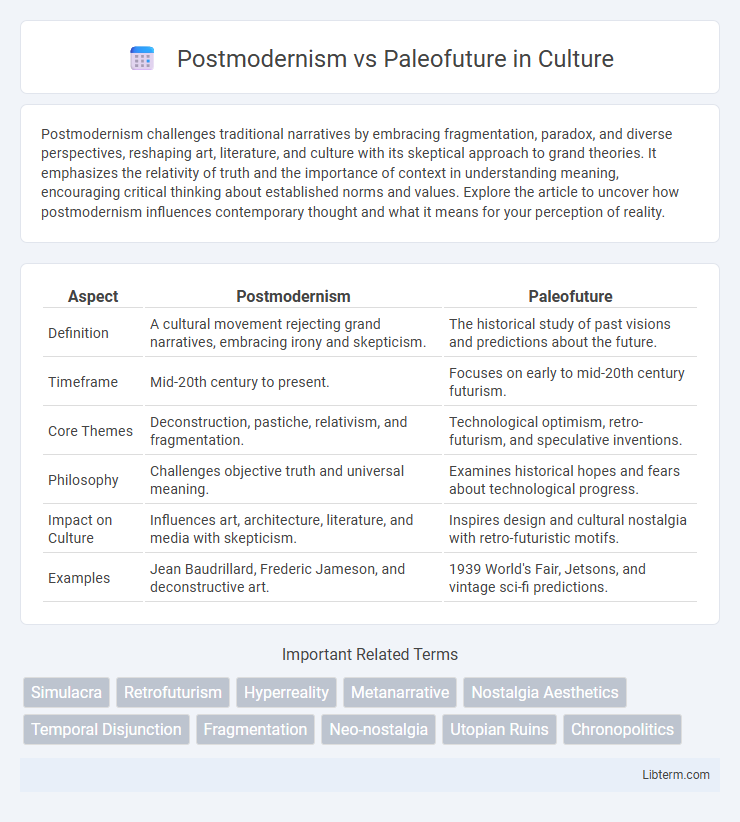Postmodernism challenges traditional narratives by embracing fragmentation, paradox, and diverse perspectives, reshaping art, literature, and culture with its skeptical approach to grand theories. It emphasizes the relativity of truth and the importance of context in understanding meaning, encouraging critical thinking about established norms and values. Explore the article to uncover how postmodernism influences contemporary thought and what it means for your perception of reality.
Table of Comparison
| Aspect | Postmodernism | Paleofuture |
|---|---|---|
| Definition | A cultural movement rejecting grand narratives, embracing irony and skepticism. | The historical study of past visions and predictions about the future. |
| Timeframe | Mid-20th century to present. | Focuses on early to mid-20th century futurism. |
| Core Themes | Deconstruction, pastiche, relativism, and fragmentation. | Technological optimism, retro-futurism, and speculative inventions. |
| Philosophy | Challenges objective truth and universal meaning. | Examines historical hopes and fears about technological progress. |
| Impact on Culture | Influences art, architecture, literature, and media with skepticism. | Inspires design and cultural nostalgia with retro-futuristic motifs. |
| Examples | Jean Baudrillard, Frederic Jameson, and deconstructive art. | 1939 World's Fair, Jetsons, and vintage sci-fi predictions. |
Introduction to Postmodernism and Paleofuture
Postmodernism challenges traditional narratives by emphasizing skepticism, relativism, and fragmented perspectives, disrupting the modernist ideal of objective progress. Paleofuture envisions the past's imagined futures, reflecting historical hopes and anxieties about technology and society, often highlighting outdated or speculative predictions. Both concepts engage with temporal perceptions--Postmodernism critiques contemporary realities while Paleofuture reexamines retro-futuristic visions.
Defining Postmodernism: Key Concepts and Characteristics
Postmodernism challenges the modernist emphasis on absolute truth and objective reality, embracing skepticism, irony, and fragmented narratives. Key characteristics include pastiche, metafiction, and paradox, which deconstruct traditional boundaries between high and low culture. This contrasts with Paleofuture's nostalgic visions of the future, as postmodernism critically interrogates progress and technological utopianism.
What is Paleofuture? Origins and Core Ideas
Paleofuture is a cultural and historical concept that explores past visions and predictions of the future, often from the late 19th to mid-20th centuries. It originates from the study of vintage science fiction, retro-futurism, and technological forecasts made during earlier eras, emphasizing the optimism and technological utopianism characteristic of those times. Core ideas include revisiting obsolete futuristic technologies, reflecting on how past societies imagined progress, and analyzing the cultural impact of these future-oriented dreams on modern innovation and nostalgia.
Historical Context: Postmodernism vs Paleofuture
Postmodernism emerged in the mid-20th century as a reaction against the modernist emphasis on progress, objectivity, and grand narratives, reflecting skepticism towards universal truths and embracing relativism and pastiche. Paleofuture, rooted in early 20th-century futurism, illustrates historical visions of the future characterized by optimism in technology, space exploration, and societal advancements often portrayed in retrofuturistic art and literature. The historical context contrasts postmodernism's critical deconstruction of progress narratives with paleofuture's optimistic projections rooted in earlier modernist ideals.
Aesthetic Differences Between Postmodernism and Paleofuture
Postmodernism embraces eclecticism and irony, blending historical styles with contemporary elements, often deconstructing traditional narratives and emphasizing fragmented, contradictory aesthetics. Paleofuture envisions the future through retrofuturistic lenses, characterized by optimistic, streamlined designs inspired by mid-20th-century futurism, featuring bold geometric shapes, chrome finishes, and an emphasis on technological utopianism. The stark contrast lies in postmodernism's skepticism towards progress and uniformity, contrasting with paleofuture's nostalgic idealization of a harmonious, technologically-driven future.
Impact on Art, Architecture, and Design
Postmodernism reshaped art, architecture, and design by embracing eclectic styles, irony, and historical references, promoting complexity and contradiction in aesthetic expressions. Paleofuture, rooted in futuristic optimism from earlier eras, influenced design through utopian visions, streamlined forms, and technological motifs, emphasizing progress and innovation. The contrast lies in Postmodernism's critical, pluralistic approach versus Paleofuture's celebratory, forward-looking ideals, each leaving a distinct legacy on creative disciplines.
Influence on Technology and Futurism
Postmodernism challenges traditional narratives by promoting skepticism toward grand technological progress, emphasizing fragmented and decentralized visions of the future, which contrasts sharply with Paleofuture's optimistic and often utopian predictions rooted in early 20th-century technological advancements. Paleofuture, reflecting early futurism, showcases a strong belief in progress through inventions like jetpacks, nuclear power, and space colonies, influencing contemporary retro-futuristic designs and cultural aesthetics. The tension between Postmodernism's critique of technological determinism and Paleofuture's idealized futurism shapes ongoing debates in technology policy, design, and speculative futures.
Cultural Critique: Contrasting Philosophies
Postmodernism challenges grand narratives and embraces skepticism toward objective truths, emphasizing cultural relativism and fragmented identities as tools for cultural critique. Paleofuture, in contrast, idealizes past visions of the future, often critiquing contemporary society through nostalgia and retro-futuristic aesthetics to highlight perceived losses in technological optimism and social progress. These contrasting philosophies reveal divergent approaches to understanding cultural development, with Postmodernism deconstructing established meanings while Paleofuture reconstructs past aspirations to critique present realities.
Postmodernism and Paleofuture in Popular Media
Postmodernism in popular media challenges traditional narratives through fragmented storytelling, self-referentiality, and irony, evident in films like "Pulp Fiction" and TV shows such as "The Simpsons." Paleofuture, on the other hand, explores past visions of the future, often highlighting outdated technology and optimism from the mid-20th century, showcased in retro-futuristic art, magazines, and series like "The Jetsons." Both movements critically engage with cultural meaning, where postmodernism deconstructs reality and paleofuture reflects on historical futurism.
Future Perspectives: Synthesis and Legacy
Postmodernism deconstructs grand narratives and embraces fragmented, pluralistic futures, challenging linear progress and highlighting the subjective nature of technological and societal advancements. Paleofuture envisions optimistic, often retrofuturistic futures rooted in mid-20th-century ideals of innovation, emphasizing sleek design, space exploration, and utopian technology. Synthesizing these perspectives reveals a legacy where speculative futures balance critical skepticism with imaginative optimism, influencing contemporary cultural narratives and design philosophies.
Postmodernism Infographic

 libterm.com
libterm.com